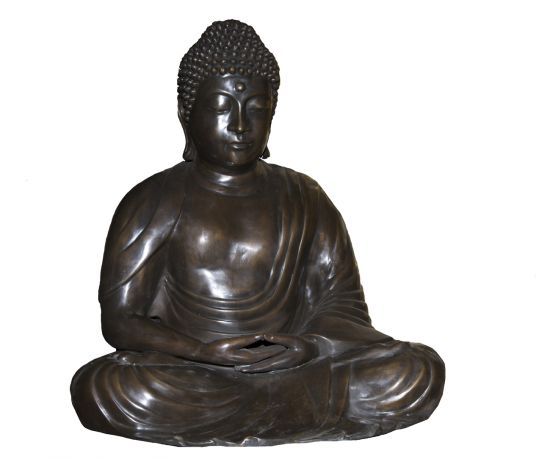We use cookies to make your experience better.
Bronze Japanese Zen Buddha XXL
Zen is a form of Buddhism which puts a strong emphasis on dhyana ie concentration meditation. This provides insight into the true nature in order to open the way to a liberated way of life. Chán is one of the major schools of Chinese Mahayana Buddhism. In Japan and the West, the school is known under the name of Zen (Japanese 禅). According to tradition, Zen originated in India, the Buddha held up a flower and Kasyappa smiled. With this he showed the wordless essence of dharma to have understood. This doctrine was transferred to Kasyappa, the second patriarch of Zen. Buddhism was introduced into China in the first century CE. Chan is the Chinese corruption of Indian dhyana meditation (ध्यान), influenced by Chinese Taoism. According to tradition Ch'an around 475 or 520 introduced by Bodhidharma, an Indian monk. He was the 28th Indian patriarch of Zen, and the first Chinese patriarch. Around that time were in the south some 2,000 temples and 36,000 monks, and in the north 6,500 temples and 80,000 monks. Buddhism which Bodhidharma advocated was based heavily on the Lankavatara-sutra, which tathagatagarba or buddha nature and alijvijnana are combined. As a result, the emphasis was on the direct sight of the true nature of the mind, namely emptiness: the true nature of man has no characteristics that can be gripped. Seeing this man awakens and breaks the illusion that creates the mind. This understanding opens the way to a liberated way of life, unhindered by the passions, desires and fears that dominate our lives. The question is to what extent the stories about Bodhidharma are historically accurate or apocryphal. In the Transfer of the lamp (t'eng shi, Transmission of the Lamp), edited by the Japanese Zen master Keizan (born in 1253), and who are not accurate historical record, are aspects of the Bodhidharma legend perspective. It is said that Bodhidharma not on a reed but on a small boat crossed the Yangtze River. Founded in 1968 Leo Boer and Jan Willem van de Wetering a Zengroep, and two books of the second helped to make Zen popular in Netherlands. The group's leadership was taken over by Erik Bruijn, who still has a thriving zengemeenschap. The largest Zen-organization is currently Zen.nl (CRKBO certified) of Rients Ritskes, a social enterprise with about 30 centers.
The ethnic Chinese Buddhists have a more or less separate movement. Their main representative, also a sign of integration in the Netherlands and "cultural beacon of Amsterdam's China Town ', the He Hua temple on the Seawall. This is primarily staffed by nuns associated with the Buddha's Light International Association in Taiwan. A parallel process took place at the Vietnamese, which represents a not insignificant group of immigrants since the eighties. They established their own 'Van Hanh Pagoda'tempel in under the smoke of Amsterdam, in Nederhorst den Berg. Live there permanently some Vietnamese Mahayana monks, but because of the nature of Buddhism in Vietnam, there is also some cooperation with Theravada teachers.
| Dimensions | 350x330mm |
|---|











